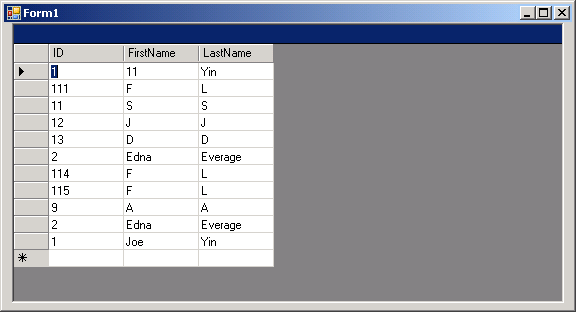DataGrid: Load data table with data reader

Imports System
Imports System.Data
Imports System.Windows.Forms
Imports System.Data.SqlClient
Imports System.IO
public class MainClass
Shared Sub Main()
Dim form1 As Form = New Form1
Application.Run(form1)
End Sub
End Class
Public Class Form1
Inherits System.Windows.Forms.Form
#Region " Windows Form Designer generated code "
Public Sub New()
MyBase.New()
'This call is required by the Windows Form Designer.
InitializeComponent()
'Add any initialization after the InitializeComponent() call
End Sub
'Form overrides dispose to clean up the component list.
Protected Overloads Overrides Sub Dispose(ByVal disposing As Boolean)
If disposing Then
If Not (components Is Nothing) Then
components.Dispose()
End If
End If
MyBase.Dispose(disposing)
End Sub
'Required by the Windows Form Designer
Private components As System.ComponentModel.IContainer
'NOTE: The following procedure is required by the Windows Form Designer
'It can be modified using the Windows Form Designer.
'Do not modify it using the code editor.
Friend WithEvents DataGrid1 As System.Windows.Forms.DataGrid
<System.Diagnostics.DebuggerStepThrough()> Private Sub InitializeComponent()
Me.DataGrid1 = New System.Windows.Forms.DataGrid
CType(Me.DataGrid1, System.ComponentModel.ISupportInitialize).BeginInit()
Me.SuspendLayout()
'
'DataGrid1
'
Me.DataGrid1.DataMember = ""
Me.DataGrid1.HeaderForeColor = System.Drawing.SystemColors.ControlText
Me.DataGrid1.Location = New System.Drawing.Point(8, 0)
Me.DataGrid1.Name = "DataGrid1"
Me.DataGrid1.Size = New System.Drawing.Size(552, 280)
Me.DataGrid1.TabIndex = 0
'
'Form1
'
Me.AutoScaleBaseSize = New System.Drawing.Size(5, 13)
Me.ClientSize = New System.Drawing.Size(568, 285)
Me.Controls.Add(Me.DataGrid1)
Me.Name = "Form1"
Me.Text = "Form1"
CType(Me.DataGrid1, System.ComponentModel.ISupportInitialize).EndInit()
Me.ResumeLayout(False)
End Sub
#End Region
Private Sub Form1_Load(ByVal sender As System.Object, ByVal e As System.EventArgs) Handles MyBase.Load
DataGrid1_Navigate(sender, Nothing)
End Sub
Private Sub DataGrid1_Navigate(ByVal sender As Object, ByVal ne As System.Windows.Forms.NavigateEventArgs) Handles DataGrid1.Navigate
' Create Connection object
Dim thisConnection As New SqlConnection("server=(local)\SQLEXPRESS;" & _
"integrated security=sspi;database=MyDatabase")
' Create Command Object
Dim thisCommand As New SqlCommand _
("SELECT * FROM Employee", thisConnection)
' Create Data Reader
Dim thisReader As SqlDataReader
Try
' Open Connection
thisConnection.Open()
' Load data table with data reader
thisReader = thisCommand.ExecuteReader()
Dim dt As New DataTable("Employee")
dt.Load(thisReader)
' Bind data table to datagrid
DataGrid1.DataSource = dt
' Close Reader
thisReader.Close()
Catch ex As Exception
MessageBox.Show(ex.Message)
Finally
' Close Connection
thisConnection.Close()
End Try
End Sub
End Class
Related examples in the same category